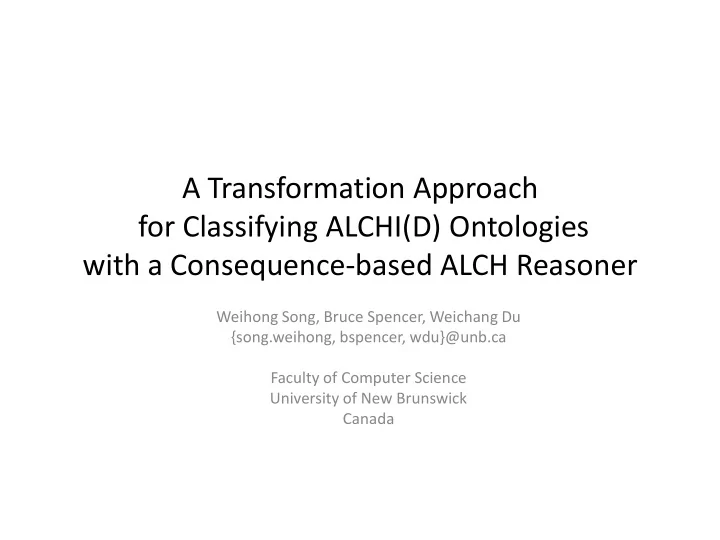

A Transformation Approach for Classifying ALCHI(D) Ontologies with a Consequence-based ALCH Reasoner Weihong Song, Bruce Spencer, Weichang Du {song.weihong, bspencer, wdu}@unb.ca Faculty of Computer Science University of New Brunswick Canada
Overview • Background: CB-based techniques provide efficient classification for limited DL languages such as ALCH but not ALCHI(D) • Goal: create an ALCHI(D) reasoner using a CB- based ALCH reasoner (ConDOR) as a black box • Approach: transform inverse role axioms and (a subset of) OWL2 datatypes and facets into ALCH axioms and classify transformed ontology with ConDOR • We can guarantee soundness and completeness of classification results for I and a subset of D 2
Overall Procedure • Three Stages: Stage 1: Transform ALCHI(D) ontology O into an ALCHI ontology Stage2: Transform the ALCHI ontology into an ALCH ontology Stage3: Classify the ALCH ontology with ConDOR Eliminate Datatypes Add Encode Data Eliminate Classify with Strengthening Ranges and Data Axioms Inverse Roles ConDOR Properties Stage2 Stage3 Stage1 3
The supported datatype features are: • datatypes owl:real – facets • owl:rational, xsd:decimal, xsd:integer – comparison facets • xsd:minInclusive, xsd:maxInclusive, xsd:minExclusive, xsd:maxExclusive • datatype xsd:string • datatype xsd:boolean 4
Stage 1: Eliminate Datatypes • Step1: encode features and data ranges – Encode features into roles and data ranges into concepts • Three types of atomic data ranges: – d, e.g., real – d[f] , e.g., real[rational], real[>2] – {v} , e.g., {1} 5
Stage 1: Eliminate Datatypes • Step 2: Add strengthening axioms to preserve the subsumptions between atomic concepts in O. – The strengthening axioms show the implicit relationships among data ranges before encoding – The purpose of strengthening axioms is to ensure data-range-relationship-preserving property – The property is sufficient for preserving completeness 6
Stage 1: Example Integer 1, 2 7
Types of Strengthening Axioms • Relationships among real[int], real[dec] and real[rat] – e.g. • Relationships among DRs of the form real[>a] – e.g. • Relationships between {v} and real[int]/real[dec]/real[rat] – e.g. • Relationships between {v} and real[>a] – e.g. 8
Types of Strengthening Axioms • Relationships among DRs of the form {v} – e.g. • Other relationships – e.g. a b -1 0 1 2 3 9
Strengthening Axioms for the Example 10
Stage 2: Transform Inverse Role • Polynomial elimination of inverses – Calvanese et al[1], – Tuned for tableau reasoning, Ding [2] • We eliminate inverse role using normalized form tuned for consequence-based reasoning. [1] Diego Calvanese, Giuseppe De Giacomo, Riccardo Rosati: A Note on Encoding Inverse Roles and Functional Restrictions in ALC Knowledge Bases. Description Logics 1998 [2] Yu Ding's PhD Thesis, http://users.encs.concordia.ca/~haarslev/students/Yu_Ding.pdf [3] Yu Ding, Volker Haarslev, Jiewen Wu: A New Mapping from ALCI to ALC. Description Logics 2007 12
Stage 2: Transform Inverse Role • Complement role hierarchy – Add r* = r’ if r – = r’, r – =r* – Add if r – = r’, s – = s’ and • Add axioms based on the equivalence 13
Proof of Soundness • For datatypes, encoding ensure a countermodel of can be converted to a countermodel of • For inverse roles, soundness is obvious since all strengthening axioms are implied by the original ontology 15
Theoretical Proof of Completeness • For both datatypes and inverse roles, strengthening axioms enables conversion of countermodels – A countermodel for to a countermodel of to a countermodel of • Proving data-range preserving property: case-by- case analysis of combinations of atomic data ranges 16
Evaluation Highly cyclic ontologies 17
Conclusion and Discussion • WSClassifier – Transforms common OWL2 datatypes, facets and inverse role axioms from ALCHID into ALCH – Classifies using an ALCH reasoner • Results – Preserves soundness and completeness for ALCHI(D) – Outperforms tableau-based reasoners on large and highly cyclic ontologies. • Future work – Extensions to other datatypes and facets – Further optimization 18
Thank you ! 19
Recommend
More recommend